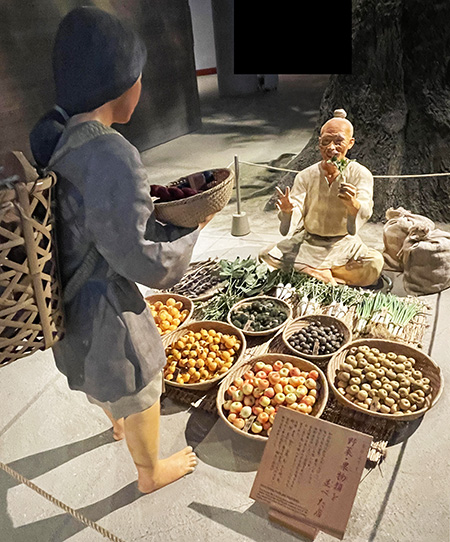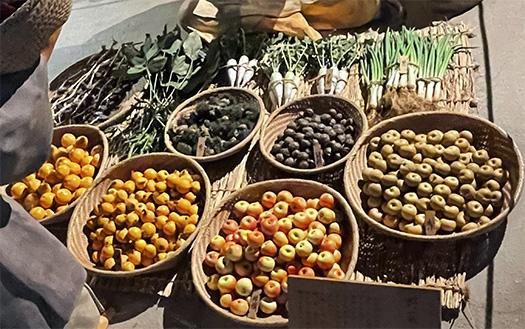

博物館展示での楽しみは「時代考証」が見えるかたちで再現されること。
表面的な政治動乱などの様子は詳細に研究されるけれど、
一般民衆の「生き様」の部分というのはなかなか再現されない。
そんなことに着目するのはややフェッチなのでしょうか。
写真は奈良県立万葉文化館地下のジオラマ展示。
こういうのにゾッコンにさせられます(笑)。
このジオラマの設定は「歌垣〜うたがき・かがい」の場で
野菜や果物、青果を販売する老人と買い求める女性の様子。
驚かされるのは取引商品のうち、わかりやすい「リンゴ」「大根」の
大きさが現代とはまったく違って小型であること。
リンゴはほとんど栗くらいの木の実として表現されている。
これでは一口でまるごと口に収まってしまいそうで、
ちょっと歯ごたえに乏しいかも知れないけれど、
これはこれで面白い食感を楽しめそうだなと感じさせられる。
品種を特定できないけれど、柑橘類のようなものも販売されている。
大根も商売人の老人が手に取って紹介しているけれど、
これはニンジンか、と思えるほどのサイズ感。
1回大根おろしを作ったら、ほぼ1人前で消えて無くなるほどに
かわいらしい大きさ。あ、おろし金などは普及していないか。
小ぶりなので5-6本を束ねてセット販売されている。
家族単位での食用ではふつうこれくらいの取引だったとも思える。
となりに展示されている「長ネギ」も大根と大差ないので
ほとんど「薬味」としての食用利用だったことが偲ばれる。
この老人の店は青果専門の業容だけれど、魚類はもっぱら行商スタイルか。
内陸部の大和盆地には河川交通で運ばれたろうけれど、
こういう路面販売では鮮度維持の課題がながく問題だっただろう。
老人の脇には丈夫そうな麻袋が置かれていて、
このなかに販売用の青果が詰め込まれ、
店舗面を構成するムシロとセットで路面店舗が作られた。
ひとが集まる場に容易に出張ることができるので、
非常に「スーパー」なマーケットというように思える。
老人はこぼれるばかりの笑みを浮かべているけれど、
「営業」というイメージが強く立ち上ってくる。
初源的な商業行為をみるような気がしてくる。
一方で買う側の女性は背中に大きな編みカゴを背負い、
片手にもザルを持っている。
貨幣というものがまだまだ根付いてはいない時代、
購買にあたっても「物々交換」が基本だったことが推定され、
このように買い物もなかなか大変な肉体労働だったと思える。
一度こんな老人のお店で買い物をして見たい(笑)。
English version⬇
Food Culture and Ingredients at the Time of Manyo Asuka Historical Testimony-6
Trading fruits and vegetables in an exchange-type commerce. The V-sign is telling the price or inviting laughter? …
One of the pleasures of museum exhibits is that the “historical research” is reproduced in a visible form.
Although superficial political upheavals are studied in detail, the “way of life” of the general populace is not so easily reproduced.
but it is difficult to reproduce the “way of life” of ordinary people.
Is it a bit of a fetish to focus on such things?
The photo shows the diorama exhibit in the basement of the Nara Prefecture Complex of Manyo Culture Museum.
This is the kind of thing that makes me fall in love with it (laughs).
The setting of this diorama is a place of “Utagaki – song and music.
An old man sells vegetables, fruits, and produce, and a woman buys them.
What is surprising is that among the products traded, the sizes of “apples” and “radishes,” which are easy to understand, are very different from those of today.
The size of the apples and daikon radishes, which are easily recognizable, are quite different from those of today.
The apple is represented as a nut almost the size of a chestnut.
It seems as if it would fit in one’s mouth in one bite.
It may lack a little bit of crunchiness, but this is an interesting texture to enjoy.
However, it is an interesting texture to enjoy.
There are also some citrus-like fruits on sale, although I cannot identify the variety.
An old merchant holds up a daikon radish and introduces it to us, but we can’t help but wonder if it is a carrot.
They are so big that one might think, “Is this a carrot?
After one serving of grated daikon, it would be gone in about one serving.
It is a cute size. I wonder if grating machines are widely used in Japan.
Since they are small, they are sold in sets of 5-6 daikon grated in bundles.
I think this is how much they were usually sold for family use.
The “long green onions” displayed next to them are not much different from daikon radish.
It is remembered that they were mostly used as “condiments” for food.
The old man’s store specializes in fruits and vegetables, but fish is sold exclusively by hawkers.
Fish would have been transported to the inland Yamato Basin by river transportation, but this kind of street sales would not be able to maintain freshness.
However, the issue of maintaining freshness must have been a problem for this type of street vendor.
Beside the old man was a sturdy-looking jute bag.
The old man was flanked by sturdy burlap sacks, into which produce for sale was packed.
The street-level store was built in combination with the mushiro that made up the store’s facade.
The storefront was built in combination with the mushiros that made up the store’s surface.
It seems to be a very “super” market, as it can easily go to places where people gather.
The old man is all smiles, but the image of “sales” stands out strongly.
The image of “sales” rises strongly.
It is as if we are witnessing a primordial commercial act.
On the other hand, the woman on the buying side carries a large woven basket on her back and a colander in one hand.
On the other hand, the woman on the buying side carries a large woven basket on her back and a colander in one hand.
This was a time when money had not yet taken root.
It is presumed that “barter” was the basic method of purchasing goods.
Shopping was also a very hard physical labor.
I would like to shop at such an old man’s store once (laugh).
Posted on 6月 26th, 2022 by 三木 奎吾
Filed under: 未分類







コメントを投稿
「※誹謗中傷や、悪意のある書き込み、営利目的などのコメントを防ぐために、投稿された全てのコメントは一時的に保留されますのでご了承ください。」
You must be logged in to post a comment.